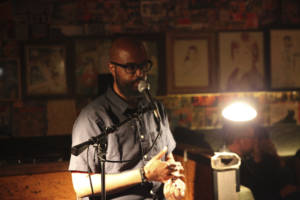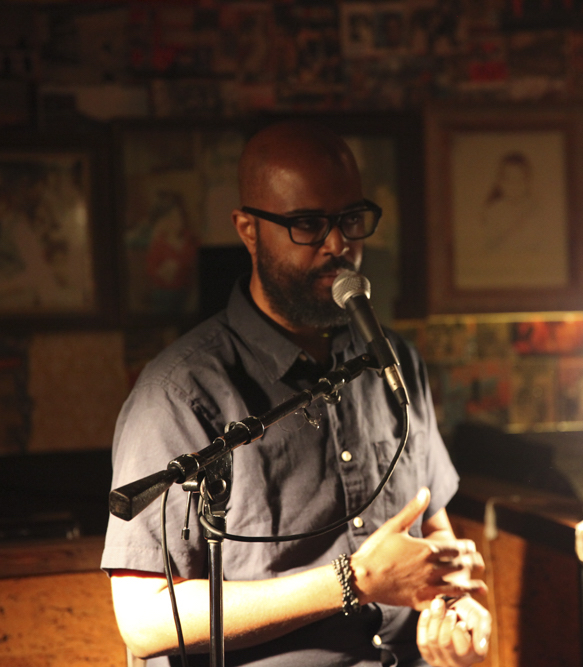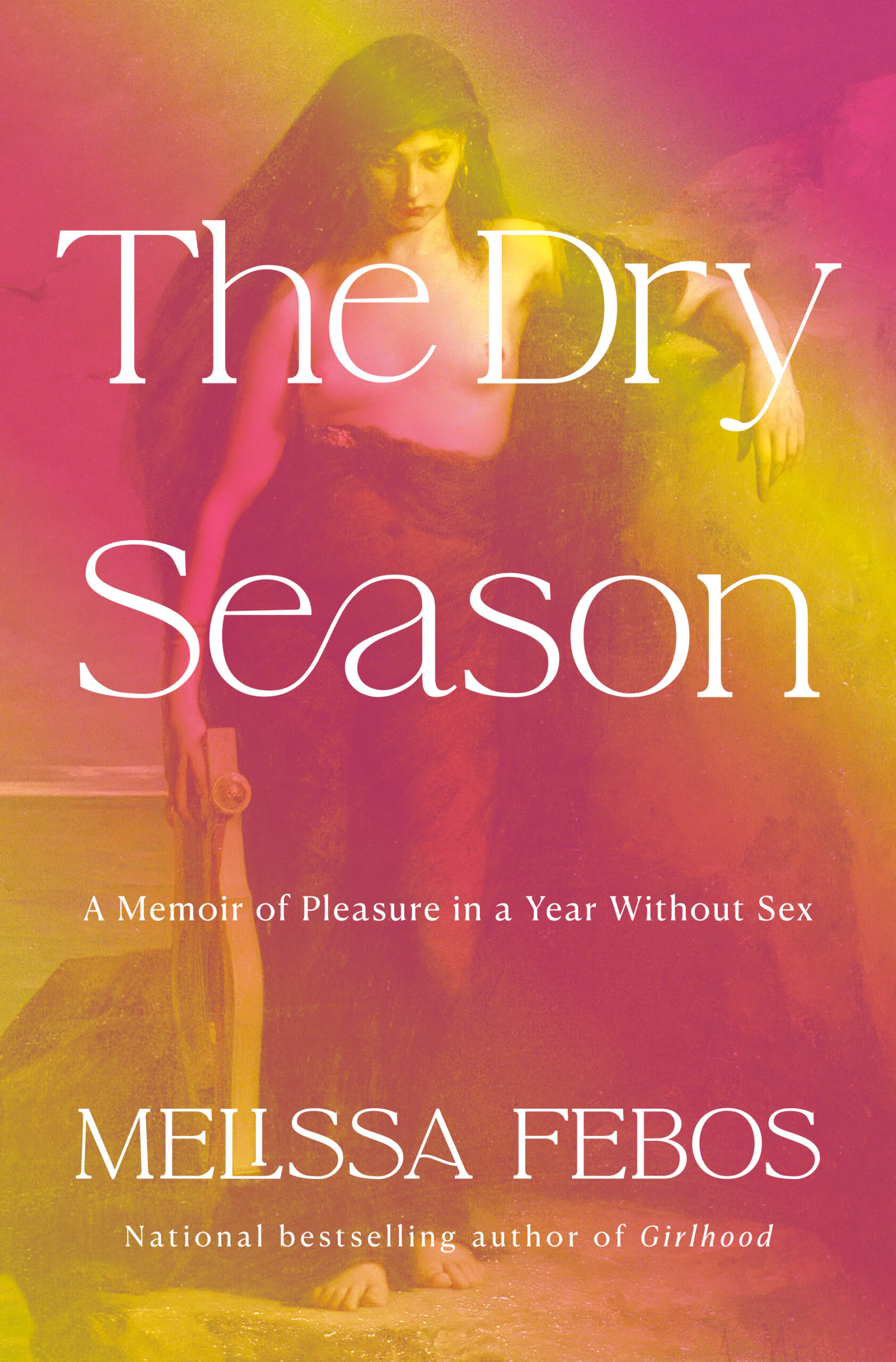MELODY NIXON interviews MENSAH DEMARY

Mensah Demary as an editor is most known for his work with Catapult Nonfiction, and more recently, Black Balloon. But Mensah Demary the writer is a force to be reckoned with. The Common published his essay “Blood and Every Beat” in our most recent issue, No. 13. In this month’s Q&A, Interviews Editor Melody Nixon talks with Demary about audience and desire, creative partnerships, “getting out of his own way,” and why the personal essay is not dead (“the idea is absurd”).
Melody Nixon (MN): In your essay “Blood and Every Beat” in the latest issue of The Common, you encompass the national and the personal in one breath. You tie together national politics, the election of Trump, and body-level anxiety and a fear of heart attacks; private moments of solitude with your partner, and public moments of racism, at the micro-aggressive and institutional levels; writing and democracy. “I edit for money, liberating my writing, but what do I know about freedom? I was told to vote, so I voted, but here we are.” Is this essay an attempt to make sense of the global at the level of the body, through “every [heart] beat”?
Mensah Demary (MD): Yes, I think you’ve nailed it, and thank you for the great question. I hadn’t thought about the essay in those terms until now. I remember the night I sat down and wrote it. Carrie Fisher had died that night—when I wrote how my partner informed me of Fisher’s death minutes earlier, that was, or is, in real time—and I was listening to Run The Jewels 3 for the first time. I just started thinking about Disney, and the Star Wars franchise, and the movie Rogue One, which I enjoyed, and the expanding Skywalker storyline thanks to the new trilogy, starting with The Force Awakens, and the new president, and how all of it related to my personal anxiety. Everything is connected and I just have to chase the threads when I write, to recreate in an essay the patterns I see.
MN: Viet Thanh Nguyen noted recently that writers in America are awakening now, forced to come out of passive slumber and claim a place as opinionated, public intellectuals. With your editorship at Catapult—which you’ve written about cogently and in a down-to-earth way—your public profile has increased. How do you relate to Nguyen’s comment?
MD: Writers need to write, to see the world for what it is, absent appeal to wish fulfillment, then find the best language and descriptions to render onto the page the world as they see it—or perhaps I’m speaking only for myself. Widen your perspective, gain empathy, remain intellectually curious and skeptical, these things will wake you up. If it took the US presidential election for some—myself included—to wake up, then so be it. But it remains to be seen if the election has caused true awakening or, for some, merely disturbed an ongoing slumber. Premature retrospectives on how we got here don’t interest me. I don’t need any more public intellectuals telling me what they think will happen in the world; they don’t know any more than you or I. Writers need to claim a place in public as writers, and let the work speak for itself.
MN: What is the role of the personal—and let’s expand that to the personal essay, since you’re a nonfiction writer—in times of collective crisis and reawakening, such as now? I.e., Is and can a politics of the personal be enough, and if so, where can it take us?
MD: The personal reinforces the physical world in which we live; collective crisis and reawakening are terms that all lead back to death—our anxiety in realizing our lives will end, and we cannot predict how, or when, and the mortal threat the physical world poses to us at all times. The personal should inspire you to live, and live more, before you die.
The personal essay is not dead; the idea is absurd. Literature is wholly human; it lives and dies on whether we’re around sharing our personal stories or not. If you don’t want to read personal essays that’s your prerogative, and if you do not wish to pay writers to write and publish them—if you’d rather pivot to video—that too is your choice. The essayist can do more with the personal, however. It’s what I’ve tried to do in my Tinyletter, and with “Blood and Every Beat” and other essays. I’m still figuring out how to do more with the personal. I’m not even sure what I mean by more. More creative? More artistic? More entertaining to the reader? Just—more. The essay is such a flexible and expansive form; it’s perfect to me. I can do anything in an essay, and still cater to hardliners expecting of an essay nothing but facts, as if we still agree on what’s true or false anymore, assuming we ever did.
MN: “Blood and Every Beat” has an organic flow and an associative style. There’s a right-brain, unconscious-like, linking of elements that brings to mind the essay writing of Eduardo Galeano, Bernard Cooper, or Tisa Bryant: that suggests and sparks in the reader subconscious connections (science is just starting to recognize the unconscious as an essential element of the creative process). Does this resonate for you? What role does the un/subconscious play in your writing, and/or writing process?
MD: Yes, that resonates—at least, I’ve more or less arrived at the same conclusion when thinking about my work. I just want to get out of my own way. So long as the essay makes sense, that the associations work organically as you read—this is the interplay between the conscious and the subconscious. The subconscious being what it is, it’s not like I can ever know for sure when it’s at work in my work, and where on the page. But I know it’s always present. It’s the wild mind. I can’t control it. I try to regulate it with rationale and logic, with causality. I trust that I know what I’m doing. And if I screw it up, I can always fix the piece when I edit it.
MN: Who are the writers who’ve really shaped you?
MD: Of late, I keep coming back to Borges and Bolaño, as well as other writers but these two have had the most influence on my work these days. I mention the Borges collection in “Blood and Every Beat,” the one I found and purchased during a recent trip to Chicago.
MN: Do you return to their books, works, essays, to reread them?
MD: Overall I’ve become a re-reader over the past three years, whereas before I would devour a book and simply move on to the next, new title. Nabokov preached the necessity to re-read a book, to give a book a second opportunity to work itself into your mind after the first pass and introduction to the book’s language and rhythm and secrets. I hadn’t thought about reading in those terms before.
MN: As well as editing Catapult Nonfiction, you have a role in acquisitions at Catapult/Black Balloon. Do you get to read for pleasure? If so, who?
MD: I don’t read for pleasure as much as I used to, or want to, but then again I get to read for a living, so I’m not one to complain or cry about lost leisure time. Not everything I read is good, but everything I read is educative and illuminating with respect to human experience within observable reality, the world in which we live and more or less have to reconcile ourselves to, should we wish to carry on. I’m just—wishing to be more mindful of the fact I get to do what I love for a living; while there is always an opportunity to gripe about one imperfect thing or another, I wish to maintain perspective.
On one hand, I want to read more for pleasure—meaning, I want to read for leisure, not for work. On the other hand, this wish is becoming less of a reasonable desire. It’s the price you pay for doing what you love for work; your love and your work intertwine, then blend until distinctions are blurred entirely. What happens if or when you begin to hate the work you do, in this context? Hopefully I’ll never find out but should it happen, I can always read for pleasure again as a singular pursuit. Right now, I’m reading James Baldwin, Albert Camus, Maya Angelou, Borges again, a biography of Alice Coltrane, César Aira, Sebald, Zen Mind, Beginner’s Mind by Suzuki, and others. I jump around from title to title. I re-read specific chapters. It seems to work for me.
MN: You’re a fellow Brooklynite. Where do you write: at home in Brooklyn, or in some other space? What’s it like?
MD: I write at home, mainly. I tried the coffee shop thing when I first moved here in 2012, and it worked for a time, particularly when I was unemployed and new to the city. Writing outside of my home at that time helped me feel connected to Brooklyn, even if living here brought on anxiety for the first few years. I wasn’t sure I would stay, for a time, or if I could. I’m glad I did. Moving to New York was the best decision for me. Here, I got to grow into myself. I found people who supported my work. I found my partner, my family. For all the millions of people who live here, paradoxically I found a quiet space to work and think, to practice without distraction.
MN: Does Brooklyn as a place enter your work often, as it does at the end of “Blood and Every Beat”? Which other places occur often in your work, as setting or as subject matter, and are important or formative for you?
MD: Brooklyn is entering my work more often these days, the longer I live here, but I’m also travelling more too, so I expect these other locales to appear in my work as well. At first, I had this fascination with New York as a character in a literary work; I suppose most writers who live here go through this at one point or another. That’s okay. The city is a mystery for everyone who lives here, and how you decode and solve that mystery is a matter of personal preference. Some take photos, others collect experiences; I wrote the same essay over and over again for the first three years I lived here. More and more, New Jersey, where I was born, is returning to my work. Georgia, too, as I slowly write my book.
MN: About that… What can you tell us about it? Is this a recent project? Something that’s been in the work for a long time? Fiction or non-?
MD: I can’t talk about it. Blame it on superstition more so than secrecy or building up hype. The last time I told someone—my partner—about my book and in full, I felt depressed for weeks afterwards, or something like depression—melancholia, maybe? Anyway, I didn’t want to write, and I certainly didn’t want to work on the book or even open the file. Telling her about the book so early on, or at all, was like serving her a half-baked cake, soft and doughy in the middle, practically inedible. It wasn’t ready, but I talked about it as though the book was solid enough to take hits, criticisms, valuable criticisms sure, but—it couldn’t absorb the blows. Recently I did share with my agent a little description as a matter of business. She got goose bumps; she pointed to them on her arm. I’ll take this as a good sign and I figure I shouldn’t tempt fate by speaking on it any further.
MN: Your partner is the artist behind Rayo and Honey; textile art with text on cotton, which has been picked up, promoted and enjoyed by many well-known writers. She also appears in “Blood and Every Beat.” Can you talk about what it’s like for you to be in an artistic partnership, and how, as a writer and artist duo the two of you inform, support, and challenge one another’s work?
MD: I once believed artistic partnerships meant that two people in love work together and, for lack of a better word, meddle in each other’s art. I tried this in the past, thinking that two writers or artists in a relationship automatically equaled partnership. It didn’t, and it never worked for all parties involved. For me, I always resented the meddling. But there are degrees to artistic partnerships, and it takes time and practice to find the right approach. Early on, we found it advantageous for us to work as though we were advisors instead of collaborators. [My partner] has asked me for my opinions on her art and business. At first I felt uncomfortable telling another artist what to do, someone I love, but [I took it that] she was merely asking for my opinion because she respects my opinion, and takes it into consideration—the final decision is hers.
It’s slightly different when it comes to my work because I’ll write and revise a piece for quite some time before she sees it. I won’t speak in details about what I’m writing; to do this means I’m talking about something that still doesn’t exist, and I don’t want to jinx things. In the case of “Blood and Every Beat,” I didn’t share it with her until it was published, so maybe four months went by between completion and her read. This was all on me. She looms large in the piece, more so than other essays. I was nervous about revealing too much about her. It was a cause for concern throughout the time I worked on the piece. In this way, she challenges me. She’s the reader I imagine when I write—her intellect and imagination and literary taste, specifically. If she doesn’t like something I’ve written, it’s not that I simply throw the piece away, but I conclude that it’s not done, that it needs more work.
I want to impress her, whereas in the past I don’t think such a thing ever mattered to me, or crossed my mind. I don’t know if I have the same impact on her, and to me it’s fine if I don’t. I love her work. I love that other writers know and support her work. She’s one of the most creative and visionary artists I’ve ever met. I hope I’ve had some impact on her, if for no other reason because, in the name of reciprocation, she has impacted my work in incalculable ways, and I would only wish to return the favor.
MN: Lastly, I want to touch on your personal newsletter, Regular Genius, which is written in first person, and reveals intimate details: your early start that morning because of travel, your recent weight loss and how weight loss and editing involve a similar sort of chipping away. Though the tone is not as confessional (or incriminating) as, say, the infamous first-person emails of Stephen Elliot, I’ve learned a lot about you as a person. Can you describe the intention behind these emails, and the role/function they play in your ongoing writing practice?
MD: At first, I tried writing personal letters to people I may or may not know. Most of my readers, at least hundreds of them if not more by now, are strangers to me, but a handful of them are my friends, and perhaps, secretly, members of my family. I find it difficult to generate the requisite intimacy in my letters, so I then switched to a more newsletter-y format, with links and information. I’ve changed and renamed my Tinyletter at least four times in the past year, if not more.
I don’t know what my readers want. This is a challenge. I’m not so self-absorbed as to think readers want to know everything about my personal life. But I am solipsistic, and I doubt this will ever change, so I figure I’ll make it my advantage. So now, I try to share my personal perspective—inward looking out, instead of inward looking deeper within, getting lost in my own miasma. I used to do this. It made for great practice, and for creative failures. I hope more people read more of my work. It’s all I ever wanted, to be a writer many people—millions of people—have chosen to read over and again. I don’t have a million subscribers to my Tinyletter, but it would be nice, I think. I don’t know. I just want to connect with people. I thought that was what all writers wanted. I now know better, but it’s still my desire.
*
Mensah Demary’s essay “Blood and Every Beat” appears in Issue No. 13 of The Common.
*
Melody Nixon is the Interviews Editor for The Common.
*
Headshot credit: Franklin Park Reading Series.




